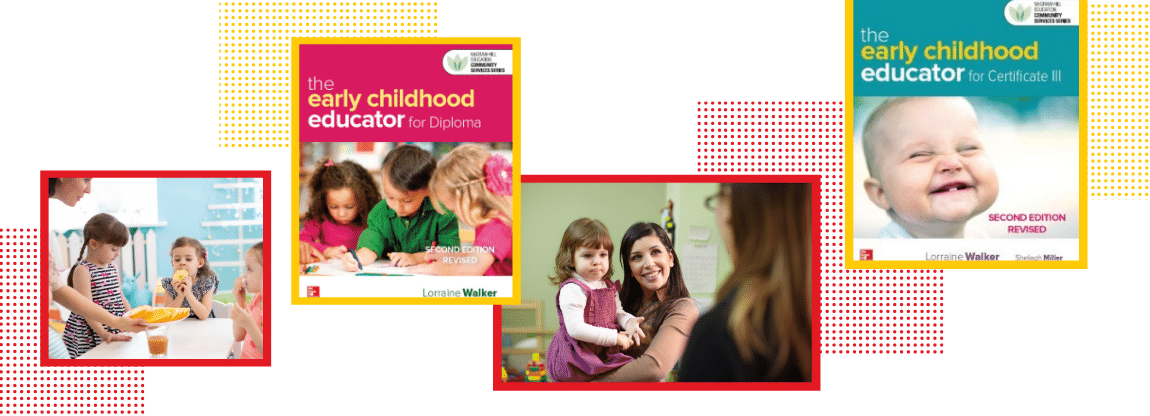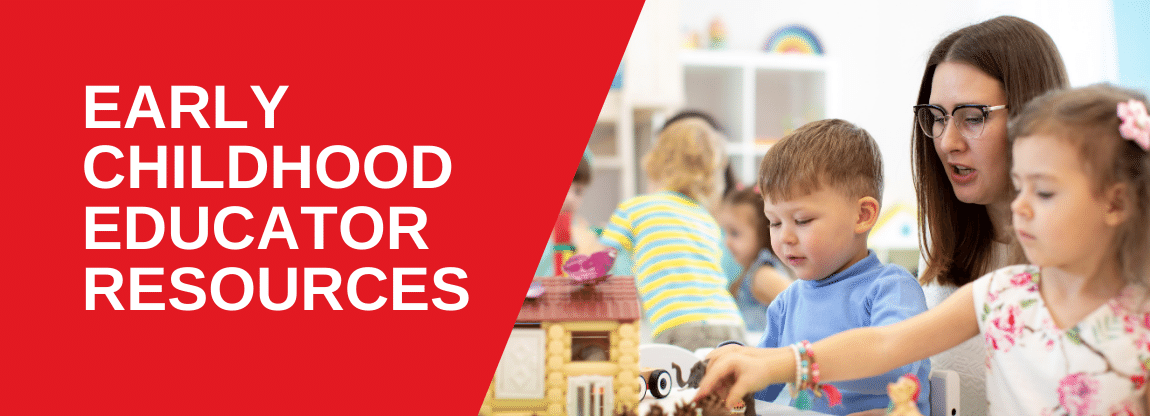Third editions of Early Childhood Educator texts coming soon!
The team at McGraw Hill are busy working behind the scenes, developing resources and eagerly waiting for the final endorsement of CHC30120 Certificate III in Early Childhood Education and Care, and CHC50120 Diploma of Early Childhood Education and Care. The Children’s Education and Care Training Package (TP) is due for submission to AISC in December 2020, and there is a presumption that the final endorsement will occur by early 2021.
A BRIEF BACKGROUND TO THE NEW CHILDREN’S EDUCATION AND CARE TP
This TP stemmed from the Australian Government’s, Australian Skills Quality Authority (ASQA) Report, 2015, Training for early childhood education and care in Australia[1]. This report drew on the findings of the Australian Government’s Productivity Commission Research Report 2011, Early Childhood Development Workforce,[2] and the Australian Government’s Productivity Commission Inquiry Report, 2014, Child Care and Early Childhood Learning[3]. ASQA’s report (2015) states that:
Of particular concern to ASQA were the Productivity Commission’s findings that ‘the quality of early childhood education and care training delivered by registered training organisations (RTOs) is highly variable’ and that ‘concerns about poor training from RTOs are widespread’ (2011a, p. 203).
This concern translated into key recommendations that influenced the new TP:
- The inclusion of minimum benchmarks for training required for each unit of competency and each VET qualification
- Industry peak bodies to report concerns about RTOs to ASQA, specifically the quality of training and assessment
- The quality of assessments to be improved
- Revisions of the TP to improve clarity of wording and assessment expectations
- Adequate training and assessment to take place in an actual or simulated workplace
- Trainers and assessors to maintain vocational competence
Aspects of these recommendations are evident in the new TP, for example, numbers 1, 3, 4 and 5.


McGRAW HILL’S UPDATED AND IMPROVED TEACHING AND LEARNING RESOURCES
Our new chapters are being written with the intent of having an even stronger alignment with the revised TP. A main objective is to release our new texts and ancillary products soon after the final endorsement of the TP. At that stage, our draft chapters are to be revised and finalised according to the TP’s final endorsement requirements. We strongly believe that this is essential as it ensures true alignment and is, therefore, the best option.
We’re making multiple changes to our resources based on industry feedback. One requested change being more detail, especially in regard to Developmentally Appropriate Practice (DAP) and information about educational theories and theorists. This change is also evident in the soon to be endorsed TP. The extent of the 3rd edition text books has been significantly increased to incorporate these requirements.
Changes to textbook features
- The body of Knowledge (BOK) which relates to the core teaching and skills required to work in the early childhood education and care (ECEC) sector, as represented in Unit of Competency (UOC) elements, performance criteria, foundation skills, and performance and knowledge evidence are even more explicit. This is another reason for the increase in the size of the textbooks as there is more in-depth content about each and every performance criteria which are now clearly signposted in every chapter.
- The formative in - text activities check a student’s understanding and provide opportunities for students to reflect and to reengage with the relevant BOK. There is an emphasis on student reflection to correlate with the new TP requirements. These in text activities (both from the 2nd edition and new ones written to correspond with new text) have been evaluated and refined to ensure relevance with the elements, performance criteria, foundation skills, and performance and knowledge evidence.
- The in-text At Works which are included as demonstrations of real life practical application of the adjacent text have been evaluated, changed or new ones created to suit BOK changes.
- The Educator’s Tips provide pertinent additional information for a student to reflect on and, very often, introduce more sources for research, to further support a student’s knowledge and understanding. They act as an enrichment of the surrounding text.
- National Quality Standard (NQS) and the Early Years Learning Framework (EYLF) quotations continue to be embedded in the text. The new TP is strongly aligned to the NQS so this has resulted in more direct quotations. This is intended to familiarise students with the National Quality framework (NQF) documents. There is an increased expectation prevalent in the new TP that Certificate III students will engage and understand framework principles, practices and learning outcomes. This is reflected in our new chapters. Importantly, NQS quotes are updated as required.
- A detailed reference list at the end of each chapter aligns with the in-text references, and also additional resources included in the educator’s tips. All references demonstrate correct formats for including them in-text as a guide for students’ assessments. Importantly again, website and video references are updated for every edition and every revised edition.
- In-Focus features were introduced for longer chapters in the Diploma text books in the 2nd edition. There are now additional In Focus features as many of the new chapters have increased in size with the extent increase. In the Certificate III text, In Focus features provide information about early childhood theories and theorists as well as information connected to each element in other longer chapters. The Diploma text provides information about different theoretical understandings and perspectives (including historical perspectives); stages of the planning cycle; a range of curriculum approaches; a selection of reflective practices in practise; and the assessment process. In Focus features provide enrichment to each of the longer chapters’ content.
- End of chapter case studies are a representation of real world events in an educator’s practice. They holistically encapsulate the elements of each chapter and include summative assessments in the form of a series of questions relatable to a chapter’s elements.
- End of chapter review questions offer an open book opportunity for students to reflect on their understanding and learning of a completed chapter. The summative questions focus on each chapter’s key performance criteria.


Changes to online resources
- The instructor resource material is presented in McGraw Hill’s Connect platform and is available both online and offline. The resources are designed to support the time poor teacher in preparing and delivering more engaging lessons and cater for the diverse learning styles of their students with:
- A resource competency mapping guide: This exhaustive document maps all resources (print and digital) to the UOC being addressed. A teacher would be able to identify which chapter, heading, and accompanying digital assets cater to which particular UOC to design their lessons. A new inclusion is a mapping document for each chapter’s foundation skills, elements and performance criteria, performance and knowledge evidence, and case study questions.
- A teacher implementation guide that shows how all resources(print and digital) can be used in delivery of a unit. This includes best practice in utilising all the assets available such as: the textbook, PowerPoint summaries, YouTube playlist, worksheets and mapping documents.
- PowerPoint slides are tagged and mapped to the knowledge evidence for each chapter. Primarily designed for supporting lesson delivery, the PowerPoint slides can also be assigned or made available to students for catch up lessons or review.
- An instructor manual to prepare for lessons. The manual contains solutions to in-text activities, end of chapter case studies and questions, and worksheets which combine practical and written tasks to assist instructors to assess performance evidence.
Hopefully, this Blog has addressed your questions. Should you wish to reach out with more questions or comments, please email vet_anz@mheducation.com. This mailbox is regularly monitored and communication will be forwarded appropriately.
Lorraine Walker on behalf of the McGraw Hill team
[1] Australian Government’s, Australian Skills Quality Authority (ASQA) Report, 2015, Training for early childhood education and care in Australia, https://www.asqa.gov.au/sites/default/files/Strategic_Review_2015_Early_Childhood_Education_Report.pdf?acsf_files_redirect
[2] Australian Government’s Productivity Commission Research Report, 2011, Early Childhood Development Workforce, https://www.pc.gov.au/inquiries/completed/education-workforce-early-childhood/report/early-childhood-report.pdf
[3] Australian Government’s Productivity Commission Inquiry Report, 2014, Child Care and Early Childhood Learning.

